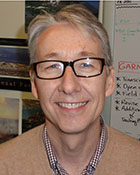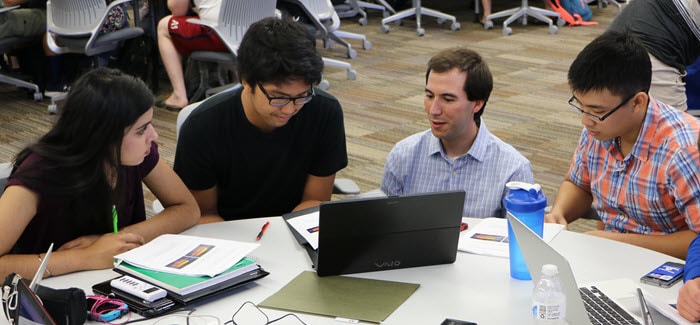David McConnell sees both benefit and paradox in active learning.
McConnell, a professor of marine, earth and atmospheric sciences at North Carolina State University, spoke to members of the geology department at KU last week about his research into active learning and his work in helping others adopt active learning techniques in their classes.

Decades of research has provided ample evidence about the benefits of active learning, McConnell said. Failure rates decline when instructors move away from lecture and use hands-on problem solving, group work, and similar techniques in their classes. Students in active learning classes do better on tests than their peers who have received traditional instruction through lecture. Performance gaps diminish. And all students learn better when they actively monitor their understanding through a variety of activities, a process known as metacognition.
Paradoxically, though, only a small proportion of college instructors have embraced active learning, McConnell said. That proportion is growing, he said, albeit slowly.
McConnell is part of an organization called On the Cutting Edge, which has been working to expand the adoption of active learning in geoscience courses. The organization sponsors workshops, provides course materials, visits classes, and conducts research aimed at improving geoscience education.

The biggest challenge in expanding active learning is time, McConnell said. That often means giving instructors a semester away from teaching duties to create activities, videos, and lesson plans that will allow them to take a more hands-on approach in the classroom.
Even then, active learning can be a tough sell. At research universities, professors get little credit for their teaching even though it generally accounts for a similar proportion of their time as research. Until universities reward teaching in the promotion and tenure process, McConnell said, only the truly motivated will adopt active learning.
Here are some other areas McConnell touched on:
Think of learning as you would a workout. To make gains, you must push yourself beyond your comfort level. Set goals and work steadily toward those goals. Work with others who will push you, but realize that you will often fail. That’s an important part of the process. “My job is to get you to fail because only then will you know your limits,” McConnell tells his students.
We are not our students. Instructors who have Ph.D.s were not average students when they were in college. They learned how to learn on their own and excelled at many levels of college work. McConnell urged instructors to avoid the trap of assuming their students have the same skills and learn in the same way. Most students need help in learning how to learn and in learning how to succeed in our classes and at our universities. “We have to adapt to the students we have,” McConnell said.
Make learning relevant. One reason students dismiss various disciplines is that they don’t see the application of the material. Instructors must make that relevance readily apparent and help students make connections to their lives. In doing so, though, instructors should hold students to high standards. “We don’t think enough of our students,” he said. “They will rise to the challenge.”
Doug Ward is the associate director of the Center for Teaching Excellence and an associate professor of journalism. You can follow him on Twitter @kuediting.